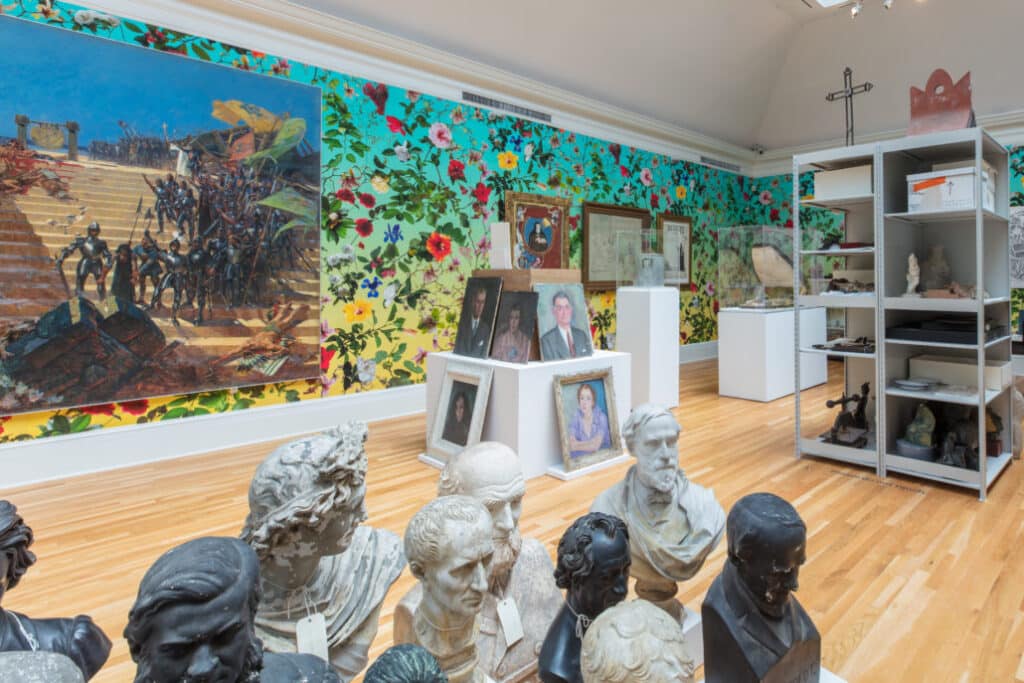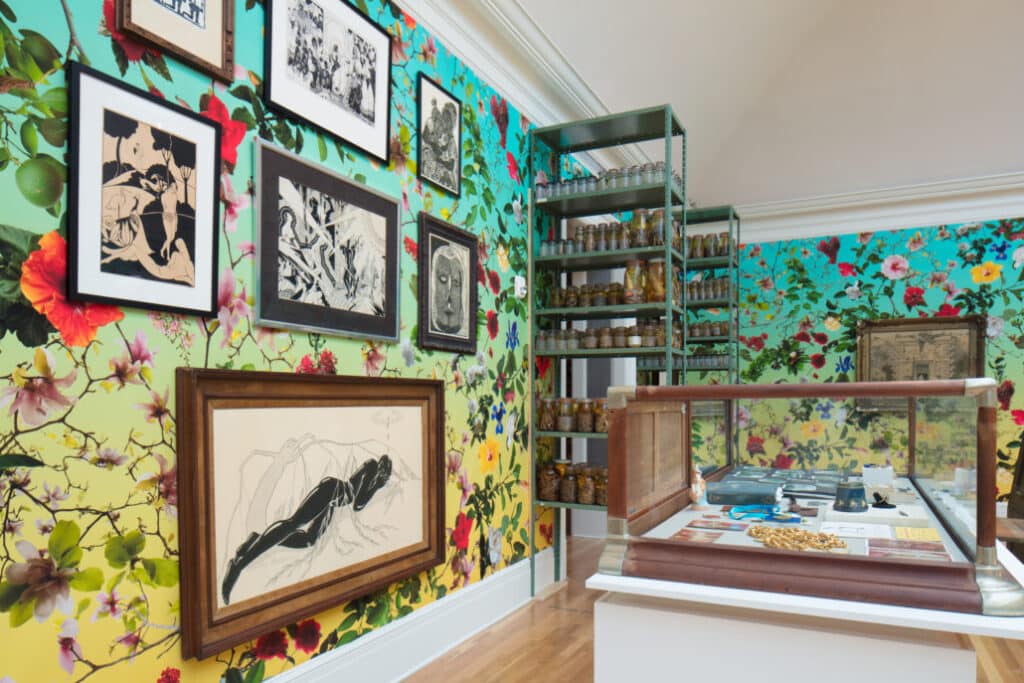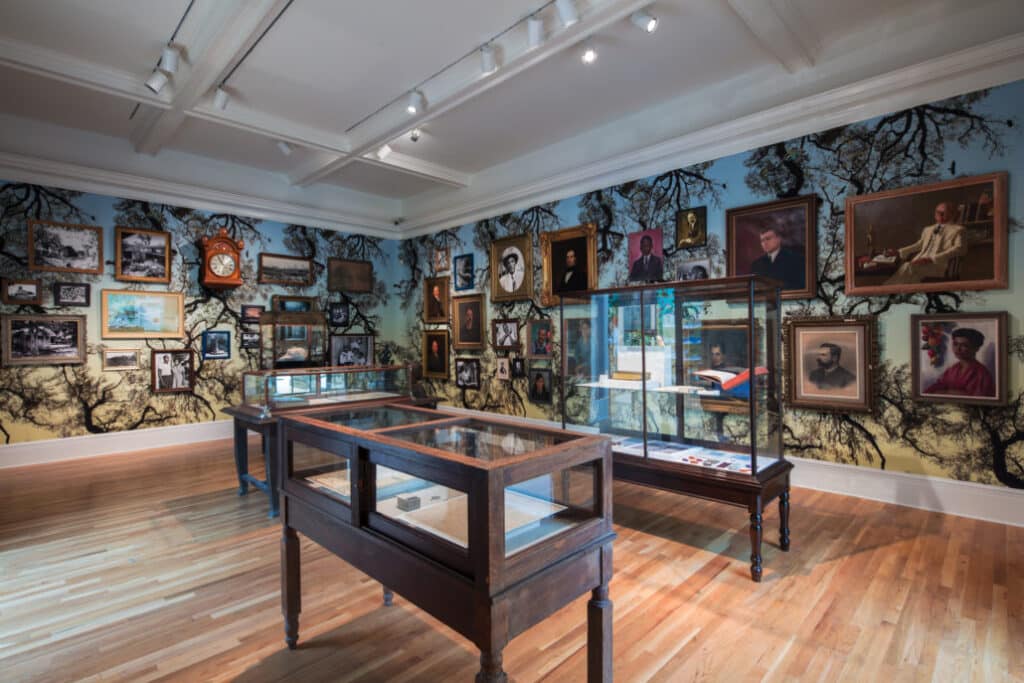Projects
FALLEN FRUIT at MANIFESTA 12

Section: Garden of Flows
Fallen Fruit is part of Manifesta 12, the twelfth edition of the European nomadic biennial, taking place in Palermo from 16 June until 4 November. The Fallen Fruit art installation (Teatro del Sole- by Fallen Fruit, David Allen Burns and Austin Young, 2018 installation) will be at the magnificent Palazzo Butera of Palermo, located in the historical Kalsa district.

EMPIRE, Newcomb Art Museum, 2018

Celebrating the New Orleans Tricentennial, EMPIRE is an art installation by Los Angeles-based artists Fallen Fruit, David Allen Burns and Austin Young, commissioned and presented by Newcomb Art Museum, A Studio in the Woods and Pelican Bomb. Through this assemblage of over 300 objects, the artists will transform the entire museum into one immersive artwork.
The project uses objects culled from the diverse archives and collections across campus, including art, sound, documents of record, material culture, and artifacts. It activates objects held by the Newcomb Art Museum, Middle American Research Institute, Newcomb College Institute, Latin American Library, Royal D. Suttkus Fish Collection / Tulane University Biodiversity Research Institute, the Hogan Jazz Archive, the Amistad Research Center, and the Louisiana Research Collection, among other campus collections, shifting the lexicon of historical meanings into one work of art.
EMPIRE critically examines the principles of archives and anthropology to interrogate the ways histories are told, remembered, and revised. The immersive artwork considers the historical and contemporary effects that colonialism, slavery, trade, and tourism have had on the movement of culture across and beyond borders to better understand the geographic and cultural position of New Orleans in relationship to Africa, the Caribbean, and Latin America. EMPIRE invites viewers to creatively interpret the displayed objects, their connections, and their juxtapositions to generate new meanings.
Fallen Fruit’s EMPIRE at Newcomb Art Museum is made possible in part through the generous support of The Andy Warhol Foundation for the Visual Arts, Jennifer Wooster (NC’91), Lora and Don Peters (A&S’81), the Newcomb College Institute of Tulane University, and the Newcomb Art Museum advisory board. Newcomb Art Museum and Fallen Fruit want to thank the Joan Mitchell Center, Louisiana Endowment for the Humanities, and Tulane’s New Orleans Center for the Gulf South, Amistad Research Center, Middle America Research Center, Louisiana Research Collection, and the Latin American Library for making this exhibition possible. EMPIRE at Newcomb Art Museum of Tulane University is part of “Fallen Fruit of New Orleans” a suite of site-specific projects taking place throughout New Orleans from June 2017 through June 2018, commissioned and presented by Newcomb Art Museum, A Studio in the Woods, and Pelican Bomb. “Fallen Fruit of New Orleans” was initiated by Pelican Bomb in 2015.








Endless Orchard, Buffalo, NY

What if instead of going to the grocery store for an apple, you just walked outside your door? The ENDLESS ORCHARD by Fallen Fruit is a way that anyone anywhere can plant, map, and share fruit! The Endless Orchard is a real living fruit orchard planted by the public, for the public – a movement of citizens transforming their own neighborhoods.
Fallen Fruit Magazine- LOVE
What the world needs now is love sweet love…. and fruit.
Fallen Fruit Magazine, The “Love” Edition is a zine made by Fallen Fruit (David Allen Burns and Austin Young) It was a 3 hour collaboration on Natoma Street, San Francisco, California, on July 29, 2017, 3-6pm with Sites Unseen and everyone who participated.
Continue reading “Fallen Fruit Magazine- LOVE”Division of Identification

Throughout Park Blocks and the fence in the middle of the parking lot in front of the first park block at 1122 NW Davis St, Portland, OR
Continue reading “Division of Identification”Public Fruit Parks in Columbus Ohio

Fallen Fruit’s Heirloom Trellis, 2017
Spring 2017, artists David Burns and Austin Young partnered with the Wexner Center and community organizations to create two public fruit parks in Columbus—Weinland Park Berry Patch (at East 11th Avenue and North 4th Street) and South Side Fruit Park (at South Washington and Reeb Avenues). The parks are a part of Fallen Fruit of Columbus: Block after Block, a suite of evolvinge South Side site-specific projects designed to provide area neighborhoods with a shared resource (fruit!) and spaces for collaboration. The parks were accompanied by an installation at the Wex that reflected the culture and history of these marginalized neighborhoods.
Continue reading “Public Fruit Parks in Columbus Ohio”The Monument to Sharing

Monument to Sharing
Public Artwork
Fallen Fruit (David Burns and Austin Young)
2017
A grove of 32 orange trees in planters located near the Ann Street Entrance of Los Angeles State Historic Park. Each planter has a phrase from a neighbor in the surrounding community. The phrases become a poem. We gathered the phrases as we planted over 150 trees in the neighborhood surrounding the park.
Continue reading “The Monument to Sharing”Fallen Fruit Issue #3: Utopia

Fallen Fruit Magazine
Public Participatory Project- ongoing
Fallen Fruit (David Burns and Austin Young)
2017
Mccoll Center for Art and Innovation
In addition to providing the materials for their public participatory project, Fallen Fruit Magazine, which included cutouts of various fruit and fashion magazines, the artists asked participants while they worked to think about the theme of “Utopia” and current events, such as the Women’s March on the day after the 2017 presidential inauguration.
Continue reading “Fallen Fruit Issue #3: Utopia”Urban Fruit Trail, Omaha

Fallen Fruit: Urban Fruit Trails, Omaha
Fallen Fruit
David Burns and Austin Young
2015
Urban Fruit Trails was organized in conjunction with the exhibition Fallen Fruit: Power of People, Power of Place. Curated by Nicole Caruth.
Urban Fruit Trails invites the public to explore urban space through a network of apple trees that form a series of walking trails. Planted along sidewalks and interstitial urban spaces, the pathway of the apple trees aims to connect Omaha neighborhoods from north to south. Bilingual signage (Spanish and English) placed at each tree reads: “These fruit trees belong to the public. They are for everyone, including you. Please take care of the fruit trees. When the fruit is ripe, taste it and share it with others. This apple tree is ripe in September/October.”
The Practices of Every Day Lives
David Burns and Austin Young/Fallen Fruit, (American)
The Practices of Everyday Life, 2016
Site-specific installation for 21c at Proof On Main. Mixed media, including wallpaper, painting, prints, and found objects
“Fallen Fruit’s immersion into the people and places that have shaped this community reveals a multitude of stories and connections in a visually dazzling and profoundly genuine expression of place making,” said Alice Gray Stites, 21c Museum’s ground-breaking director and chief curator. “21c is proud to have commissioned an ambitious project that is truly locally engaged and globally connected. The installation addresses a universal aspect of the human condition, hunger-to be fed, to be seen, to belong, to be loved. The persistence of these desires fosters the continuity of ritual: the practices of everyday life don’t really change-we eat, drink, we talk, we congregate and celebrate in ways that would be recognizable to our forbears at least a century ago-these acts retain meaning and promise.”
Continue reading “The Practices of Every Day Lives”










